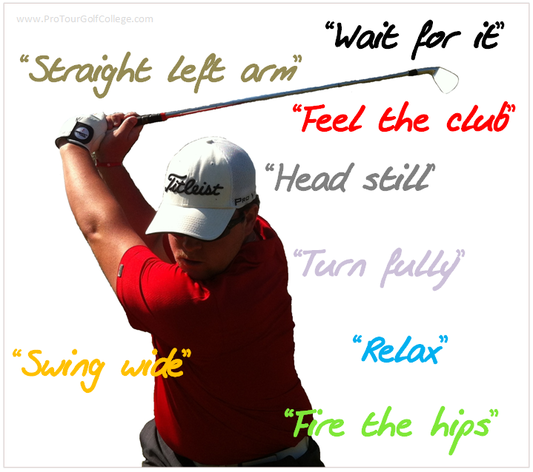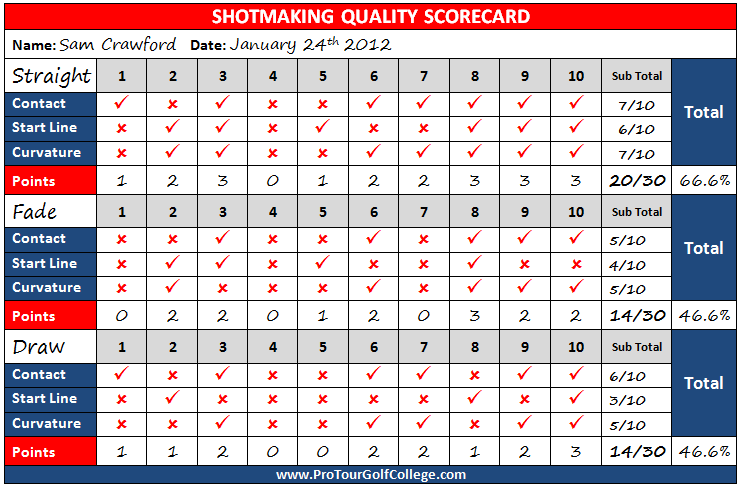 When you go to the practice fairway or driving range to work on your game what do you do work on and why? Do you work mostly on your golf swing mechanics, or do you work on controlling ball flight, or both? These are important questions if you want to improve your golf scores and become more consistent in golf tournaments. If you could just concentrate on one thing what would it be? What is the message that you will send to the muscles that move your golf club? For many golfers, the messages sent to their muscles are mixed and many and this undoubtedly leads to confusion, frustration and inevitably poor golf shots. You can make incredible progress with your golf swing if you can decide what it is you want it to do. If you start with the thought of what the goal of your golf swing is before you go to work on it. In other words you begin with the end goal in mind. Here’s a huge mistake made by many golfers though. They assume that if their golf swing looks like x it will perform like y. But how your golf swing looks and how your golf swing functions are mutually exclusive. In other words, how it looks and how it works isn’t necessarily the same thing. Swing style and swing function are different. Many golfers fall for the trap of building a golf swing that looks like a certain tour professionals only to discover it doesn’t work nearly as good. No two golf swings are the same. There are similarities but they are all different. Therefore style is not nearly as important as function is. There are many styles of golf swings but not as many functional differences. A golf swing serves a purpose and that purpose is to hit a golf ball correctly. So what is the goal of your golf swing?...  At Pro Tour Golf College we explain to our students that their golf swing has a responsibility to achieve just three objectives to be a top level amateur or tour player and they need to know what they are, and then learn to achieve them. So let’s start with an important but essentially simple presupposition; the purpose of the golf swing is to produce a correct and consistent impact so you can achieve these three objectives. And the style of your golf swing is to move your body and golf club in such a way that the outcome is that you achieve a golf shot that meets these three objectives. The Three Golf Swing Objectives All golf swings are different in style but the good ones produce consistently solid shots out of the sweet spot of the clubface with superb control over the amount of spin they produce. 1. Solid Contact Mastery For the ball to travel the distance you require you have to hit the ball out of the sweet spot which is also called the centre of percussion. Golf at the highest level is a game of control over distance more than accuracy. You need to develop your golf swing so that it hits a high percentage of shots solidly out of the clubface so your shots finish as close to the pin as possible. Tour players are experts at controlling the distance they can hit their golf shots (particularly the short irons) to within close proximity of the hole or target. One of the goals of your golf swing should be to develop your technique so that there is a high likelihood that your golf shot is hit out of the sweet spot. This means that your golf swing must function so that you can achieve this goal. If you hit more shots away from the sweet-spot of your clubface then you need to talk to your golf teacher about this and develop a strategy that changes this situation. It has been our experience that the single biggest error made by advanced amateur golfers is their inability to control the distance of their golf shots into a green. We estimate that as much as 70 percent of their golf shots finish well short of the pin. This first of the three objectives is critical to your golf swing development, and what is amazing is that it is one of the easiest to measure. A couple of pieces of electrical tape stuck to the face of your iron or wood will give you instant feedback and show you what percentage of shots you hit out of the sweet-spot. 2. Shot-Making Corridor Mastery Many of the golf courses that you will play as a competitive amateur or professional golfer require an ability to start your golf ball on the line of the clubface. What this means is the golf ball can fly straight off the clubface towards your intended target. The purpose of your golf swing is to produce a high percentage of shots that can travel in what we call the shot-making corridor. The corridor is an imaginary rectangular window that extends upwards from the target line. The objective of your golf swing is to hit a high percentage of your golf shots down your chosen target line, solidly hit with minimal curvature. When you hit longer shots with your driver, three wood or hybrid clubs it is essential that you have the ability to start the ball on the correct path so that you can hit your long shots closer to your intended target to set-up your next shot. Tour golf courses are designed for the strategic placement of golf shots and they reward those who can control the direction of their shots better than others. If you can start and keep your ball on the target line you've chosen then you can hit your shots into areas of the fairway where you are rewarded with better angles into the tough to get to places on the green. 3. Minimal and Maximal Curvature Mastery The third objective of your golf swing is to control spin or curvature. When you swing your golf club you need to control the amount of sidespin and backspin you produce on your golf ball if you’re to become a competitive amateur or professional golfer. To be able to control sidespin is the trademark of a top class golfer especially in this age of technology where the golf ball and driver is designed to hit the golf ball very straight. Old school golfers learnt to curve their golf ball as part of their playing development, but today few young amateur and professional golfers can curve the ball with control. Tiger Woods is one golfer who values old school ideals and is exceptional at controlling the amount of curvature on his shots from the tee and also into the greens. Golf is played with a spinning ball and as such your ability to either produce excessive curvature or minimal curvature when needed is a prerequisite for developing your golfing abilities further.  Whether you’re hitting a wedge into the green or a driver from the teeing ground you need to control spin and your golf swings purpose is to develop this important function. When you practice hitting golf shots on the range you should be practicing the fades and draws as well as the straight shots. And when you're practicing your short-game skills you should be practicing controlling the spin on your wedges so you can stop them faster and also make them run on. We rarely if ever see this, particularly with younger golfers who seem to be under the impression that the top tour players hit straight golf shots all the time. They don’t; top tour golfers can hit the ball with fade or draw quite easily, and they need to because many of the courses they play require the ability to hit a shape to their tee shot to position themselves for their next shot. When you’re hitting wedge shots into the green can you control the spin so that some of your wedges stop quickly whilst others release towards the pin? The one dimensional golfer practices the straight shot most of the time and doesn’t work on spin control with their wedges. Believe me when I tell you that you will get found out when it matters to you most! It is a disadvantage to hit it straight when golf courses are designed with doglegs. It is a disadvantage to hit excessively spinning wedges to a soft green; and it is a disadvantage to produce too little spin on your wedges when you’re hitting to a firm green. Learn how to hit fades and draw shots as much as you work on your straight shots, and learn how to control the amount of backspin on your wedges, and you’re well on your way to developing the second objective of your golf swing, mastering the spin on your golf ball. Your golf swing serves one purpose and it cannot serve two masters. The ultimate aim of your golf swing is to produce a consistent and correct impact with the golf ball. We live in an age where it is very easy to lose sight of this important goal and instead get caught up in the analysis of swing style at the expense of building a reliable golf swing technique. The litmus test of your golf swing is whether you can control the flight and behavior of your golf ball and the best way to do this is to measure your shot-making ability. So how do you measure the quality of the three golf swing objectives when you practice or play? At Pro Tour Golf College our students measure every golf shot they hit and one of our training drills is built around practicing the three objectives and measuring the results using the 'Shot Making Quality Scorecard.' You can see in the picture above that Sam hit 30 golf shots (Straight shot, fade shot and draw shot) and we measured contact, start-line and spin. One point was awarded for achieving each of these objectives and after 10 shots we add them up to see how he fared.
This is just one way we measure student performance at Pro Tour Golf College because without an ability to measure your results you can't manage and improve them. The golf swing style is important, but only if it can meet the three objectives. If your golf swing technique is not doing this, then you’re off-track and you need to get back to basics and work out why you can’t hit the ball where the clubface is pointing most of the time. The pathway to building the perfect looking golf swings is very popular today with high speed video cameras and computer programs to break down every part of your swing down. But this can lead you along way down the pathway of disappointment. The fundamentals of this great game haven’t changed, but they have been pushed aside in favour of the perfect looking golf swing. The best golf swing is the one that can control the three objectives most of the time. This is the purpose of your golf swing. Get this right and you can develop your golf game to the highest levels in amateur or professional golf; get it wrong and you will never become the golfer you want to become. It is that simple. The choice is yours. Lawrie Montague and David Milne - Pro Tour Golf College Comments are closed.
|
Archives
June 2019
|
Proudly Supported By
Copyright © 2011 - 2018 Pro Tour Golf College
Website Managed By Golf Performance Media
All Rights Reserved
Website Managed By Golf Performance Media
All Rights Reserved






 RSS Feed
RSS Feed



